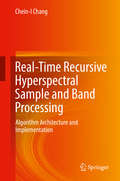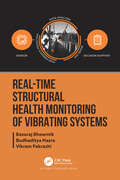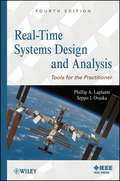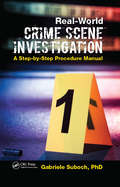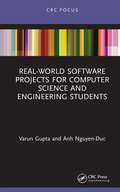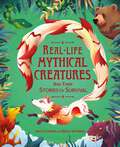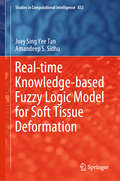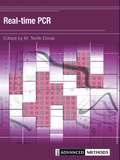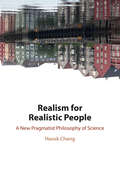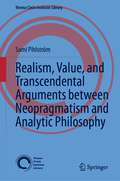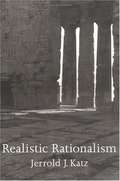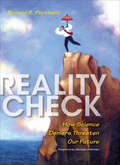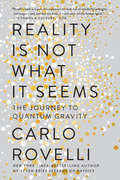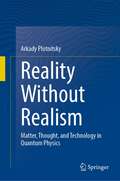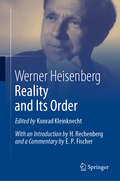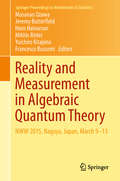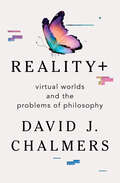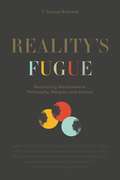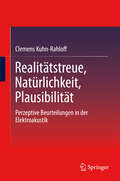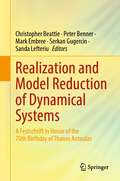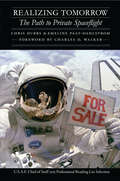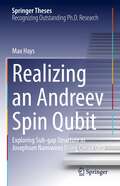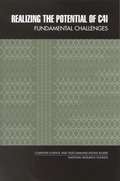- Table View
- List View
Real-Time Recursive Hyperspectral Sample and Band Processing
by Chein-I ChangThis book explores recursive architectures in designing progressive hyperspectral imaging algorithms. In particular, it makes progressive imaging algorithms recursive by introducing the concept of Kalman filtering in algorithm design so that hyperspectral imagery can be processed not only progressively sample by sample or band by band but also recursively via recursive equations. This book can be considered a companion book of author's books, Real-Time Progressive Hyperspectral Image Processing, published by Springer in 2016.
Real-Time Structural Health Monitoring of Vibrating Systems
by Vikram Pakrashi Basuraj Bhowmik Budhaditya HazraTargeted at researchers and practitioners in the field of science and engineering, the book provides an introduction to real time structural health monitoring. Most work to date is based on algorithms that require windowing of the accumulated data, this work presents a coherent transition from the traditional batch mode practice to a recently developed array of recursive approaches. The book mainly focuses on the theoretical development and engineering applications of algorithms that are based on first order perturbation (FOP) techniques. The development of real time algorithms aimed at identifying the structural systems and the inflicted damage, online, through theoretical approaches paves the way for an in-depth understanding of the discussed topics. It then continues to demonstrate the solution to a class of inverse dynamic problems through numerically simulated systems. Extensive theoretical derivations supported by mathematical formulations, pivoted around the simple concepts of eigenspace updates, forms the key cornerstone of the book. The output response streaming in real time from multi degree of freedom systems provide key information about the system’s health that is subsequently utilized to identify the modal parameters and the damage, in real time. Damage indicators connotative of the nature, instant and location of damage, identified in a single framework are developed in the light of real time damage case studies. Backed by a comprehensive assortment of experimental test-beds, this book includes demonstrations to emulate real life damage scenarios under controlled laboratory conditions. Applicability of the proposed recursive methods towards practical problems demonstrate their robustness as viable candidates for real time structural health monitoring.
Real-Time Systems Design and Analysis: Tools for the Practitioner
by Phillip A. Laplante Seppo J. OvaskaThe leading text in the field explains step by step how to write software that responds in real time From power plants to medicine to avionics, the world increasingly depends on computer systems that can compute and respond to various excitations in real time. <P><P>The Fourth Edition of Real-Time Systems Design and Analysis gives software designers the knowledge and the tools needed to create real-time software using a holistic, systems-based approach. The text covers computer architecture and organization, operating systems, software engineering, programming languages, and compiler theory, all from the perspective of real-time systems design. The Fourth Edition of this renowned text brings it thoroughly up to date with the latest technological advances and applications. This fully updated edition includes coverage of the following concepts: Multidisciplinary design challenges Time-triggered architectures Architectural advancements Automatic code generation Peripheral interfacing Life-cycle processes The final chapter of the text offers an expert perspective on the future of real-time systems and their applications. The text is self-contained, enabling instructors and readers to focus on the material that is most important to their needs and interests. Suggestions for additional readings guide readers to more in-depth discussions on each individual topic. In addition, each chapter features exercises ranging from simple to challenging to help readers progressively build and fine-tune their ability to design their own real-time software programs. Now fully up to date with the latest technological advances and applications in the field, Real-Time Systems Design and Analysis remains the top choice for students and software engineers who want to design better and faster real-time systems at minimum cost.
Real-World Crime Scene Investigation: A Step-by-Step Procedure Manual
by Gabriele SubochReal-World Crime Scene Investigation: A Step-by-Step Procedure Manual is designed as a field guide providing instruction on how to document a crime scene, including sketching, mapping, searching, collecting, and preserving physical evidence. It also addresses how to document a crime scene using photography and videography. It introduces modern fore
Real-World Software Projects for Computer Science and Engineering Students
by Varun Gupta Anh Nguyen-DucDeveloping projects outside of a classroom setting can be intimidating for students and is not always a seamless process. Real-World Software Projects for Computer Science and Engineering Students is a quick, easy source for tackling such issues. Filling a critical gap in the research literature, the book: Is ideal for academic project supervisors. Helps researchers conduct interdisciplinary research. Guides computer science students on undertaking and implementing research-based projects This book explains how to develop highly complex, industry-specific projects touching on real-world complexities of software developments. It shows how to develop projects for students who have not yet had the chance to gain real-world experience, providing opportunity to become familiar with the skills needed to implement projects using standard development methodologies. The book is also a great source for teachers of undergraduate students in software engineering and computer science as it can help students prepare for the risk and uncertainty that is typical of software development in industrial settings.
Real-life Mythical Creatures and Their Stories of Survival (Real-life Monsters)
by Anita GaneriImmerse yourself in the fascinating stories of ten real-life mythical creatures, exploring the legends that surround them, their discoveries and seeing how they survive today.From blood-sucking vampires and fiery phoenixes, to howling werewolves and shaggy-haired yetis, mysterious, and often mischievous, creatures appear in myths and legends from around the world. For centuries, they have puzzled, fascinated and frightened people, sometimes being used to teach a lesson or to warn of danger. But have these beasts ever really existed, and, most importantly, are any of them around today?This book brings together ten real-life mythical creatures, with fascinating facts and folklore. There are tales of how they were discovered, where they live, and about their adaptations for surviving in the wild.It's time to set off on the mythical monster hunt of a lifetime.ENTER IF YOU DARE!This high-interest approach to the natural world shows the diversity of nature, evolution and adaptation and can be used to support the science curriculum study of living things at key stage two.Full-colour photographs combined with illustrations make this a beautiful and fascinating introduction to real-life mythical creatures around the world.
Real-time Knowledge-based Fuzzy Logic Model for Soft Tissue Deformation (Studies in Computational Intelligence #832)
by Amandeep S. Sidhu Joey Sing TanThis book provides a real-time and knowledge-based fuzzy logic model for soft tissue deformation. The demand for surgical simulation continues to grow, as there is a major bottleneck in surgical simulation designation and every patient is unique. Deformable models, the core of surgical simulation, play a crucial role in surgical simulation designation. Accordingly, this book (1) presents an improved mass spring model to simulate soft tissue deformation for surgery simulation; (2) ensures the accuracy of simulation by redesigning the underlying Mass Spring Model (MSM) for liver deformation, using three different fuzzy knowledge-based approaches to determine the parameters of the MSM; (3) demonstrates how data in Central Processing Unit (CPU) memory can be structured to allow coalescing according to a set of Graphical Processing Unit (GPU)-dependent alignment rules; and (4) implements heterogeneous parallel programming for the distribution of grid threats for Computer Unified Device Architecture (CUDA)-based GPU computing.
Real-time PCR (Advanced Methods)
by M. Tevfik DorakWith a variety of detection chemistries, an increasing number of platforms, multiple choices for analytical methods and the jargon emerging along with these developments, real-time PCR is facing the risk of becoming an intimidating method, especially for beginners. Real-time PCR provides the basics, explains how they are exploited to run a real-time PCR assay, how the assays are run and where these assays are informative in real life. It addresses the most practical aspects of the techniques with the emphasis on 'how to do it in the laboratory'. Keeping with the spirit of the Advanced Methods Series, most chapters provide an experimental protocol as an example of a specific assay.
Realism for Realistic People: A New Pragmatist Philosophy of Science
by Hasok ChangIn this innovative book, Hasok Chang constructs a philosophy of science for 'realistic people' interested in understanding and promoting the actual practices of inquiry in science and other knowledge-focused areas of life. Inspired by pragmatist philosophy, he reconceives the very notions of reality and truth on the basis of his concept of the 'operational coherence' of epistemic activities, and offers new pragmatist conceptions of truth and reality as operational ideals achievable in actual scientific practice. Rejecting the version of scientific realism that is concerned with claiming that our theories correspond to an ultimate reality, he proposes instead an 'activist realism': a commitment to do all that we can actually do to improve our knowledge of realities. His book will appeal to scholars and students in philosophy, science and the history of science, and all who are concerned about the place of science and empirical truth in society.
Realism, Value, and Transcendental Arguments between Neopragmatism and Analytic Philosophy (Vienna Circle Institute Library #7)
by Sami PihlströmThe essays collected in this volume and authored by Sami Pihlström emphasize that our relation to the world we live in and seek to represent and get to know better through our practices of conceptualization and inquiry is irreducibly valuational. There is no way of even approaching, let alone resolving, the philosophical issue of realism without drawing due attention to the ways in which human values are inextricably entangled with even the most purely “factual” projects of inquiry we engage in.This entanglement of the factual and the normative is, as explicitly argued in Chapter 7 but implicitly suggested in all the other chapters as well, both pragmatic (practice-embedded and practice-involving) and transcendental (operating at the level of the necessary conditions for the possibility of our representing and cognizing the world in general). The author claims we need to carefully examine the complex relations of realism, value, and transcendental arguments at the intersection of pragmatism and analytic philosophy. This book does so by offering case-studies of various important neopragmatists and philosophers close to the pragmatist tradition, including Hilary Putnam, Nicholas Rescher, Joseph Margolis, and Ludwig Wittgenstein. It appeals to scholars and advanced graduate students focusing on pragmatism and analytic philosophy.
Realistic Rationalism
by Jerrold J. KatzJerrold J. Katz develops a new philosophical position integrating realism and rationalism. Realism here means that the objects of study in mathematics and other formal sciences are abstract; rationalism means that our knowledge of them is not empirical.
Reality Check: How Science Deniers Threaten Our Future
by Donald R. ProtheroA thought-provoking look at science denialism &“for popular science readers who want better to be able to explain and defend science and scientific methods to others&” (Library Journal). The battles over evolution, climate change, childhood vaccinations, and the causes of AIDS, alternative medicine, oil shortages, population growth, and the place of science in our country—all are reaching a fevered pitch. Many people and institutions have exerted enormous efforts to misrepresent or flatly deny demonstrable scientific reality to protect their nonscientific ideology, their power, or their bottom line. To shed light on this darkness, Donald R. Prothero explains the scientific process and why society has come to rely on science not only to provide a better life but also to reach verifiable truths no other method can obtain. He describes how major scientific ideas that are accepted by the entire scientific community (evolution, anthropogenic global warming, vaccination, the HIV cause of AIDS, and others) have been attacked with totally unscientific arguments and methods. Prothero argues that science deniers pose a serious threat to society, as their attempts to subvert the truth have resulted in widespread scientific ignorance, increased risk of global catastrophes, and deaths due to the spread of diseases that could have been prevented. &“Prothero&’s treatise will give the science-minded something to cheer about, a brief summary of the real data that supports so many critical aspects of modern life.&” —Publishers Weekly
Reality Is Not What It Seems: The Journey to Quantum Gravity
by Carlo Rovelli Erica Segre Simon Carnell<P><P>From the New York Times–bestselling author of Seven Brief Lessons on Physics, a closer look at the mind-bending nature of the universe.What are the elementary ingredients of the world? Do time and space exist? And what exactly is reality? <P><P>Theoretical physicist Carlo Rovelli has spent his life exploring these questions. He tells us how our understanding of reality has changed over the centuries and how physicists think about the structure of the universe today. <P><P>In elegant and accessible prose, Rovelli takes us on a wondrous journey from Democritus to Albert Einstein, from Michael Faraday to gravitational waves, and from classical physics to his own work in quantum gravity. <P><P>As he shows us how the idea of reality has evolved over time, Rovelli offers deeper explanations of the theories he introduced so concisely in Seven Brief Lessons on Physics. <P><P>This book culminates in a lucid overview of quantum gravity, the field of research that explores the quantum nature of space and time, seeking to unify quantum mechanics and general relativity. <P><P>Rovelli invites us to imagine a marvelous world where space breaks up into tiny grains, time disappears at the smallest scales, and black holes are waiting to explode—a vast universe still largely undiscovered.
Reality Without Realism: Matter, Thought, and Technology in Quantum Physics
by Arkady PlotnitskyThis book presents quantum theory as a theory based on new relationships among matter, thought, and experimental technology, as against those previously found in physics, relationships that also redefine those between mathematics and physics in quantum theory. The argument of the book is based on its title concept, reality without realism (RWR), and in the corresponding view, the RWR view, of quantum theory. The book considers, from this perspective, the thinking of Bohr, Heisenberg, Schrödinger, and Dirac, with the aim of bringing together the philosophy and history of quantum theory. With quantum theory, the book argues, the architecture of thought in theoretical physics was radically changed by the irreducible role of experimental technology in the constitution of physical phenomena, accordingly, no longer defined independently by matter alone, as they were in classical physics or relativity. Or so it appeared. For, quantum theory, the book further argues, made us realize that experimental technology, beginning with that of our bodies, irreducibly shapes all physical phenomena, and thus makes us rethink the relationships among matter, thought, and technology in all of physics.
Reality and Its Order
by Werner HeisenbergAvailable here for the first time in English, "Reality and Its Order" is a remarkable philosophical text by Werner Heisenberg, the father of quantum mechanics and one of the leading scientists of the 20th century. Written during the wartime years and initially distributed only to his family and trusted friends, the essay describes Heisenberg’s philosophical view of how we understand the natural world and our role within it. In this volume, the essay is introduced by the physicist Helmut Rechenberg and annotated by the science historian Ernst Peter Fischer. The content, particularly within its historical context, will be of great interest to many physicists, philosophers and historians of science.
Reality and Measurement in Algebraic Quantum Theory: Nagoya, Japan, March 9-13 2015 (Springer Proceedings in Mathematics & Statistics #261)
by Miklós Rédei Francesco Buscemi Jeremy Butterfield Masanao Ozawa Hans Halvorson Yuichiro KitajimaThis volume contains papers based on presentations at the “Nagoya Winter Workshop 2015: Reality and Measurement in Algebraic Quantum Theory (NWW 2015)”, held in Nagoya, Japan, in March 2015. The foundations of quantum theory have been a source of mysteries, puzzles, and confusions, and have encouraged innovations in mathematical languages to describe, analyze, and delineate this wonderland. Both ontological and epistemological questions about quantum reality and measurement have been placed in the center of the mysteries explored originally by Bohr, Heisenberg, Einstein, and Schrödinger. This volume describes how those traditional problems are nowadays explored from the most advanced perspectives. It includes new research results in quantum information theory, quantum measurement theory, information thermodynamics, operator algebraic and category theoretical foundations of quantum theory, and the interplay between experimental and theoretical investigations on the uncertainty principle. This book is suitable for a broad audience of mathematicians, theoretical and experimental physicists, and philosophers of science.
Reality+: Virtual Worlds and the Problems of Philosophy
by David J. ChalmersA leading philosopher takes a mind-bending journey through virtual worlds, illuminating the nature of reality and our place within it. Virtual reality is genuine reality; that’s the central thesis of Reality+. In a highly original work of “technophilosophy,” David J. Chalmers gives a compelling analysis of our technological future. He argues that virtual worlds are not second-class worlds, and that we can live a meaningful life in virtual reality. We may even be in a virtual world already. Along the way, Chalmers conducts a grand tour of big ideas in philosophy and science. He uses virtual reality technology to offer a new perspective on long-established philosophical questions. How do we know that there’s an external world? Is there a god? What is the nature of reality? What’s the relation between mind and body? How can we lead a good life? All of these questions are illuminated or transformed by Chalmers’ mind-bending analysis. Studded with illustrations that bring philosophical issues to life, Reality+ is a major statement that will shape discussion of philosophy, science, and technology for years to come.
Reality’s Fugue: Reconciling Worldviews in Philosophy, Religion, and Science
by F. Samuel BrainardScience, religion, philosophy: these three categories of thought have organized humankind’s search for meaning from time immemorial. Reality’s Fugue presents a compelling case that these ways of understanding, often seen as competing, are part of a larger puzzle that cannot be rendered by one account of reality alone.This book begins with an overview of the concept of reality and the philosophical difficulties associated with attempts to account for it through any single worldview. By clarifying the differences among first-person, third-person, and dualist understandings of reality, F. Samuel Brainard repurposes the three predominant ways of making sense of those differences: exclusionist (only one worldview can be right), inclusivist (viewing other worldviews through the lens of one in order to incorporate them all, and thus distorting them), and pluralist or relativist (holding that there are no universals, and truth is relative). His alternative mode of understanding uses Douglas Hofstadter’s metaphor of a musical fugue that allows different “voices” and “melodies” of worldviews to coexist in counterpoint and conversation, while each remains distinct, with none privileged above the others. Approaching reality in this way, Brainard argues, opens up the possibility for a multivoiced perspective that can overcome the skeptical challenges that metaphysical positions face.Engagingly argued by a lifelong scholar of philosophy and global religions, this edifying and accessible exploration of the nature of reality addresses deeply meaningful questions about belief, reconciliation, and being.
Reality’s Fugue: Reconciling Worldviews in Philosophy, Religion, and Science
by F. Samuel BrainardScience, religion, philosophy: these three categories of thought have organized humankind’s search for meaning from time immemorial. Reality’s Fugue presents a compelling case that these ways of understanding, often seen as competing, are part of a larger puzzle that cannot be rendered by one account of reality alone.This book begins with an overview of the concept of reality and the philosophical difficulties associated with attempts to account for it through any single worldview. By clarifying the differences among first-person, third-person, and dualist understandings of reality, F. Samuel Brainard repurposes the three predominant ways of making sense of those differences: exclusionist (only one worldview can be right), inclusivist (viewing other worldviews through the lens of one in order to incorporate them all, and thus distorting them), and pluralist or relativist (holding that there are no universals, and truth is relative). His alternative mode of understanding uses Douglas Hofstadter’s metaphor of a musical fugue that allows different “voices” and “melodies” of worldviews to coexist in counterpoint and conversation, while each remains distinct, with none privileged above the others. Approaching reality in this way, Brainard argues, opens up the possibility for a multivoiced perspective that can overcome the skeptical challenges that metaphysical positions face.Engagingly argued by a lifelong scholar of philosophy and global religions, this edifying and accessible exploration of the nature of reality addresses deeply meaningful questions about belief, reconciliation, and being.
Realitätstreue, Natürlichkeit, Plausibilität
by Clemens Kuhn-RahloffDieses Buch richtet sich an Ingenieure und Forscher im Bereich der Kommunikationsakustik und anderen Gebieten der Wahrnehmungsforschung. Es bewegt sich im interdisziplinären Feld von Kommunikationsakustik, Informationstheorie und Wahrnehmungspsychologie und liefert einen wesentlichen Beitrag zum Verständnis der akustischen Wahrnehmung. Im Zentrum steht dabei der Begriff der Plausibilität als grundlegender Bestandteil kommunikationsakustischer Technik. Um Eigenschaften von Plausibilitätsurteilen bei der akustischen Wahrnehmung zu von Menschen zu erörtern, stellt das Buch ausgewählte top-down-Prozesse der Wahrnehmung in den Vordergrund, die das Urteilsverhalten beeinflussen. Plausibilität wird im Kontext existierender Modelle für perzeptive Messungen dargestellt und die Anforderungen werden diskutiert, die an den Begriff gestellt werden, wenn er im psychoakustischen Sinn als Messgröße aufgefasst wird.
Realization and Model Reduction of Dynamical Systems: A Festschrift in Honor of the 70th Birthday of Thanos Antoulas
by Peter Benner Mark Embree Christopher Beattie Serkan Gugercin Sanda LefteriuThis book celebrates Professor Thanos Antoulas's 70th birthday, marking his fundamental contributions to systems and control theory, especially model reduction and, more recently, data-driven modeling and system identification. Model reduction is a prominent research topic with wide ranging scientific and engineering applications.
Realizing Tomorrow: The Path to Private Spaceflight (Outward Odyssey: A People's History of Spaceflight)
by Chris Dubbs Emeline Paat-DahlstromU.S.A.F. Chief of Staff 2013 Professional Reading List Selection Nearly forty years passed between the Apollo moon landings, the grandest accomplishment of a government-run space program, and the Ansari X PRIZE–winning flights of SpaceShipOne, the greatest achievement of a private space program. Now, as we hover on the threshold of commercial spaceflight, authors Chris Dubbs and Emeline Paat-Dahlstrom look back at how we got to this point.Their book traces the lives of the individuals who shared the dream that private individuals and private enterprise belong in space. Realizing Tomorrow provides a behind-the-scenes look at the visionaries, the crackpots, the financial schemes, the legal wrangling, the turf battles, and—underpinning the entire drama—the overwhelming desire of ordinary people to visit outer space. A compelling story of the pioneers of commercial spaceflight—and their efforts to open the final frontier to everyone—this book traces the path to private spaceflight even as it offers an instructive, entertaining, and cautionary note about its future.
Realizing an Andreev Spin Qubit: Exploring Sub-gap Structure in Josephson Nanowires Using Circuit QED (Springer Theses)
by Max HaysThe thesis gives the first experimental demonstration of a new quantum bit (“qubit”) that fuses two promising physical implementations for the storage and manipulation of quantum information – the electromagnetic modes of superconducting circuits, and the spins of electrons trapped in semiconductor quantum dots – and has the potential to inherit beneficial aspects of both. This new qubit consists of the spin of an individual superconducting quasiparticle trapped in a Josephson junction made from a semiconductor nanowire. Due to spin-orbit coupling in the nanowire, the supercurrent flowing through the nanowire depends on the quasiparticle spin state. This thesis shows how to harness this spin-dependent supercurrent to achieve both spin detection and coherent spin manipulation. This thesis also represents a significant advancement to our understanding and control of Andreev levels and thus of superconductivity. Andreev levels, microscopic fermionic modes that exist in all Josephson junctions, are the microscopic origin of the famous Josephson effect, and are also the parent states of Majorana modes in the nanowire junctions investigated in this thesis. The results in this thesis are therefore crucial for the development of Majorana-based topological information processing.
Realizing the Energy Potential of Methane Hydrate for the United States
by National Research Council of the National AcademiesNatural gas, composed mostly of methane, is the cleanest of all the fossil fuels, emitting 25-50% less carbon dioxide than either oil or coal for each unit of energy produced. In recent years, natural gas supplied approximately 20-25% of all energy consumed in the United States. Methane hydrate is a potentially enormous and as yet untapped source of methane. The Department of Energy's Methane Hydrate Research and Development Program has been tasked since 2000 to implement and coordinate a national methane hydrate research effort to stimulate the development of knowledge and technology necessary for commercial production of methane from methane hydrate in a safe and environmentally responsible way. Realizing the Energy Potential of Methane Hydrate for the United States evaluates the program's research projects and management processes since its congressional re-authorization in 2005, and presents recommendations for its future research and development initiatives.
Realizing the Potential of C4I: Fundamental Challenges
by Committee to Review DOD C4I Plans ProgramsRapid progress in information and communications technologies is dramatically enhancing the strategic role of information, positioning effective exploitation of these technology advances as a critical success factor in military affairs. These technology advances are drivers and enablers for the "nervous system" of the military—its command, control, communications, computers, and intelligence (C4I) systems—to more effectively use the "muscle" side of the military.Authored by a committee of experts drawn equally from the military and commercial sectors, Realizing the Potential of C4I identifies three major areas as fundamental challenges to the full Department of Defense (DOD) exploitation of C4I technology—information systems security, interoperability, and various aspects of DOD process and culture. The book details principles by which to assess DOD efforts in these areas over the long term and provides specific, more immediately actionable recommendations. Although DOD is the focus of this book, the principles and issues presented are also relevant to interoperability, architecture, and security challenges faced by government as a whole and by large, complex public and private enterprises across the economy.
